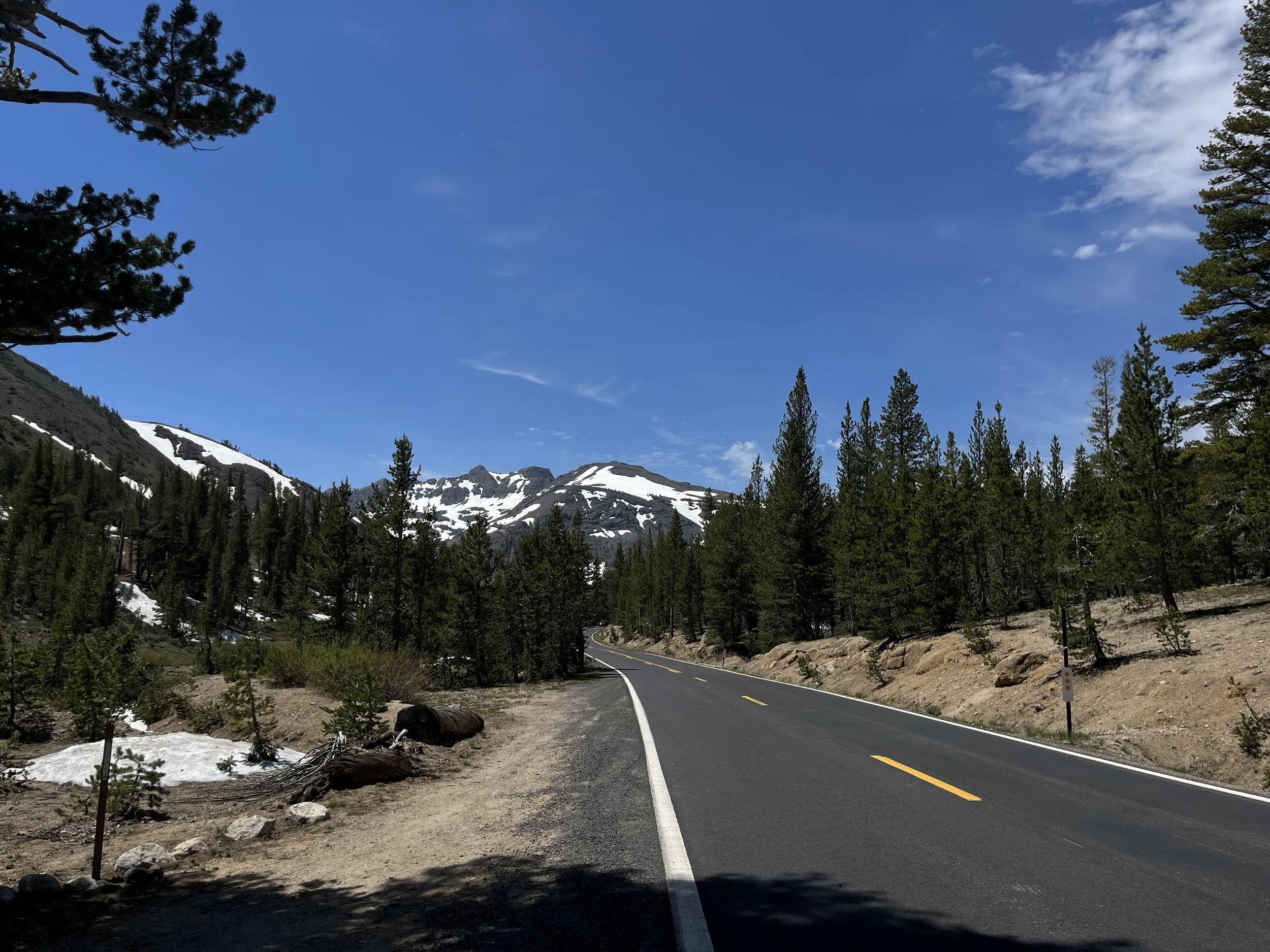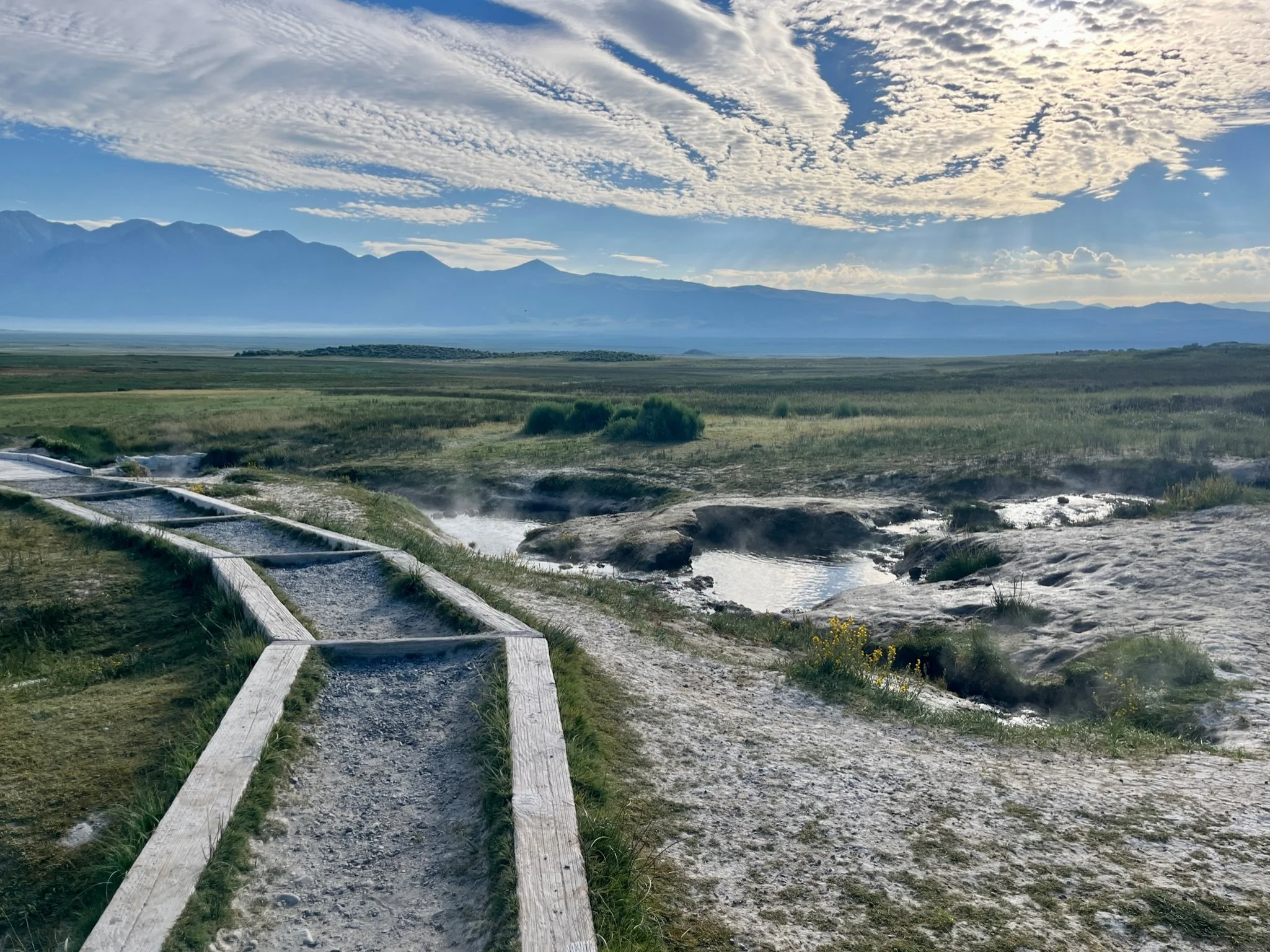Sunset to Sunrise: Making the Most of Mammoth Lakes on a Budget and a Deadline
On Monday, July 17th, 2023, I woke up on pins and needles. I felt like sprinting, skipping, and cartwheeling for joy. I equally felt like vomiting. Today, I was finally leaving on my solo cross-country road trip.
Well, not exactly solo. Not yet. For the first two days, one of my close friends was joining me, and today we were visiting our very first road trip destination: Mammoth Lakes, California.
a view of the drive to Mammoth Lakes
I have lived in California for over sixteen years but never visited Mammoth Lakes before. I’ve been to Yosemite more than twenty times. And although Mammoth Lakes is only an hour further away, somehow, four hours felt much more daunting than three. Throughout my road trip, however, four-hour drives began to feel like a breeze, especially when compared to seven or eight-hour days, sometimes back to back.
“In the end, my biggest expense was the gas it took to get to Mammoth Lakes. My second biggest expense was a pint of beer.”
We arrived in Mammoth Lakes around 2 pm and beelined for the visitors center, where a park ranger provided us with information about the town. Mammoth Lakes is the only incorporated community in Mono County, California, and sits alone in a valley of the Sierra Nevada mountains. It is best known as a popular ski resort in the winter.
Because of its desolate location and upscale commercial draw, Mammoth Lakes is notorious for being an expensive destination to visit. Gas prices in the middle of nowhere (particularly in California) can be exorbitant. I had to pay more than $9/ gallon in Bridgeport just to get to Mammoth Lakes. Plus, being a ski resort town, most accommodations, dining, and shopping options are similarly high-end, and therefore, pricy.
As a budget traveler, I couldn’t afford to drop 200+ dollars on a trip to Mammoth Lakes, no matter how gorgeous it was. And thanks to some scrappy decision making, I didn’t have to. In the end, my biggest expense was the gas it took to get to Mammoth Lakes. My second biggest expense was a pint of beer.
map of Mammoth Lakes’ location
During the summer, Mammoth Lakes’ incredible natural beauty and surrounding landmarks attract all types of outdoor enthusiasts to the town. Today, that included us. Some of the area’s featured landmarks include Mammoth Mountain, Rainbow Falls, and Devils Postpile National Monument- an impressive formation of basalt columns.
Another well known draw of Mammoth Lakes is its natural hot springs. There are several locations, all free to access and set in front of one of the most serene natural backdrops you could hope for. I spent my spare moments that day researching where the hot springs were. Since it was the middle of July, we decided to go early the next morning, before the sweltering temperature outside rose to surpass that of the hot springs (literally, unfortunately).
My friend and I explored the town for a few hours. We got coffee at Shea Schat’s Bakery (famous for its Sheepherder loaves) and had some truffles that were so, so yummy! Then we walked around the Village and did some window shopping - admittedly, I may have purchased a sticker or two for my car dashboard.
I saw a bulletin board that said a local bar called Distant Brewing Company hosted an open mic night every Monday, so we drove over and had some drinks while listening to live music. Out the window, the low-hanging sun began to cast a gold hue across the valley, so I started looking for a place for us to set up camp (AKA park the car) for the night.
I originally thought that Mammoth Lakes allowed free overnight street parking, but after driving around a bit during the day, I learned that NO overnight parking is allowed in town. So, we had to leave the town limits to find a dispersed camping spot.
If you haven’t heard the term before, dispersed camping refers to camping in undeveloped areas outside of designated campgrounds. There are several important parts to this:
No Established Campground
There is no designated campground.
This means that unlike established campgrounds, where you usually have access to a designated campsite, a maintained restroom- maybe even potable water- and generally have to pay $10- $40, nothing is provided.
You might find a divet in the ground where another camper pitched their tent before you, or if you’re lucky, a fire pit you probably can’t use unless you have double and triple-checked campfire ordinances and have all the necessary permits (campfire rules are very particular to each state, park, and forest). In other words…
Self Sufficiency
You need to be self-sufficient if you are going to dispersed camp.
That means bring your own food, water, and camping gear.
It also means that you are required (as always) to follow “Leave No Trace” principles: pack in, pack out, leave the area as you found it, pick up trash. In other words, leave no trace of your visit.
Save Money and Immerse in Nature
While dispersed camping may lack the comforts and amenities of traditional campsites, it compensates by providing an immersive and secluded wilderness experience- free of cost. It is undoubtedly a scrappy way to camp.
While dispersed camping and car camping are not synonymous, you can assume that anywhere you are allowed to dispersed camp, you are allowed to car camp. However, if free overnight parking is permitted somewhere, that does not necessarily mean that car camping is allowed.
These are important technical distinctions, but as a scrappy traveler, you will need to judge each situation individually. Sometimes there are gray areas or situations where you can assume it’s okay to bend the rules a little. Judging these things will get easier as you go. And when in doubt- Love’s Truck Stops remain a steadfast option.
I used the Eastern Sierra Camping Map to determine where we could car camp, and some quick research told me there were dispersed camping spots not too far out of town. We just needed to find them for ourselves, since there were no coordinates online. We drove a few minutes south along the highway before taking a meandering exit towards some hills and trees in the center of the valley. The sunset drive afforded us the most picturesque view of the Mammoth Mountains, glowing pink in the late sunlight. Finally, we found a spacious dirt parking lot where other car campers, RVs, and van-lifers had parked their cars, seemingly with the same idea as us.
I pulled out my propane stove and made us a pasta dinner, then we set up the bed in the back of my trunk, covered the car windows, and tucked in for the night. As a side note, it’s a good idea to keep headlamps and toilet paper in arm’s reach when you go dispersed camping (even car camping) because when you wake up in the middle of the night aching to pee, you’ll have quick access to some TP and a hands-free flashlight to light your way (no germs on the flashlight!)
When dispersed camping, you must walk at least 200 feet away from any water sources, trails, and campsites before going to the bathroom. This protects the environment and other people from the spread of illnesses. Plus, this 200 feet rule limits the number of animals you might accidentally attract to your campsite, or in our case, our makeshift caravan of travelers. For more information about how to pee like a pro in the woods, click right here.
In the morning, we drove to Wild Willy’s Hot Springs, located here. Wild Willy’s Hot Spring is one of the only locations in Mammoth where you can sit in a natural hot spring, as most other springs have man-made pools and valves that pipe in hot water from their geothermal sources. We followed this article’s directions, and after getting lost twice, finally found the parking lot.
the view from the boardwalk on our way to Wild Willy’s Hot Springs
To get to the hot springs, we walked about a quarter mile down a boardwalk until we came upon the sulfuric babbling brook and steaming pools of water. This hot spring is well known in Mammoth, but since we arrived quite early on a Tuesday, we had the entire hot spring area to ourselves for over an hour. We floated around, enjoyed the stunning 360-degree view of the mountains, and I almost fell asleep in the steamy water. This was my favorite part of visiting Mammoth Lakes, and best of all, visiting the Hot Spring was completely free!
the steaming pools of Wild Willy’s Hot Springs
If you visit any Mammoth hot springs, you should be aware that many locals treat the pools as swimsuit optional. In other words, you might run into some naked strangers, as we did, or opt to be the naked stranger if you’re feeling bold. View it as part of Mammoth Lakes’ charm.
Eventually, more people started showing up and it got uncomfortably hot outside, so we packed up and headed back to the car. After we got some coffee in town, it was time to begin the five-hour drive into Nevada… skirting around Death Valley… during a heat wave… during the hottest month of the year. With the serene image of Mammoth Mountain at our backs, we embarked on the next leg of our adventure.




